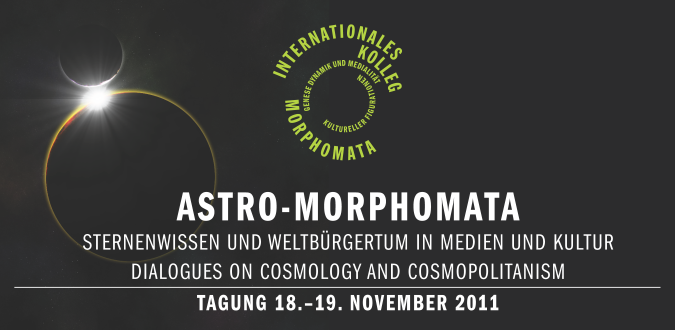
Internationales Kolleg Morphomata: Genesis, Dynamics and Mediality of Cultural Figurations
Center for Advanced Studies at the University of Cologne
(funded by the Federal Ministry of Education and Research)
Conference Directors: Sonja A.J. Neef, Dietrich Boschung & Henry Sussman
Downloads: flyer of the program contributors abstracts poster
Cosmology and cosmopolitanism describe two different types of knowledge or belief, one deriving from the study of the universe, the other from cultural studies. Both discourses, each in its own frame, deal with concepts of cosmos, universe, globe or world. Throughout history, they have been tacitly entertaining close relationships. The Astro-Morphomata-conference is devoted to the study of the various interactions between cosmology and cosmopolitanism.
The new conceptual term morphome derives from the Greek word mórphôma—the form of cultural objects arisen from figuration processes—and signifies tangible shapes: formations, artifacts and figures in which our knowledge becomes manifest. ‘Astro-morphomata’ are understood as the whole set of cultural objects and practices that belong to both cosmology and culture. The conference explores the dynamic processes by which ideas from cosmology affect cultural, political, philosophical, or religious objects or practices. It questions the sediments of cosmological knowledge in cultural norms and values and its potential to function as catalysts of cultural identity-building.
The conference is particularly sensitive to the role of the media as agents of interaction between cosmology and cosmopolitanism. It seeks to investigate how shifts in the history of media interact with epistemological and ideological changes. With the first telescopic observation of the solar system by Galileo in 1609, the old idea of a finite and geo-centric ‘cosmos’ ordered in shells was replaced by the Copernican model of an infinite ‘universe’. The telescope established a new ‘visual’ culture, i.e. a culture of the ‘ocular’ gaze, which reshaped the Aristotelian, ‘eidetic’ culture. In doing so, the telescope contributed to the epistemic changes towards modernity and Enlightenment. From the 19th century on, astral photography and radio electronics radically enlarged our knowledge of the universe. Today, in the age of space travelling and world-wide digitization, very large telescopes, satellites and space observatories force us again to reconsider our world-view, and to reinvent ourselves as post-modern and post-enlightened subjects.
This contemporary epistemic shift, however, cannot just be described in terms of advancement and progress. Rather, it necessitates exploring the infinity of extraterrestrial possibilities as much as reconsidering the particularity of Earth as a unique and finite planet. In this sense, we find ourselves confronted with the task of reformulating the pre-modern Ptolemaic question of investigating the starry sky from the perspective of a geocentric point of view. Such investigation forces us to rethink the Earthy basis of universal truth, if not even its position on either the Northern or the Southern hemisphere of our planet. With this consideration, both cosmological and cosmopolitan thought will have to be engaged in dialogues on difference.
Astro-morphomata invites contributions devoted to critically investigating the interactions between cosmological and cosmopolitan ideas as articulated in a wide set of astrocultural objects. These involve:
- (science-)fictions and beliefs: philosophical theorems, religious and mythological cults and narratives;
- artifacts from literature, arts, film (television, cinema), and music, including popular culture, cybernetic simulation, installation and new-media-art;
- architectures and places of astronomy such as the observatory (including sacred buildings used for observatory purposes), the planetarium, space research centers;
- practices such as space traveling, cults such as eclipse chasing, as much as the search for extraterrestrial life and media applications such as Google Mars.
The conference brings together scholars from different fields of the humanities, including cultural and media studies, literature, philosophy, religion studies, and the history of ideas and science. Proposals must have a clear focus on the central research aim, i.e. to come to a multi-perspective view on what the notions ‘the West’, ‘planet’, ‘globe’, ‘world’, and ‘cosmos’ mean in both cosmological and cosmopolitan terms.